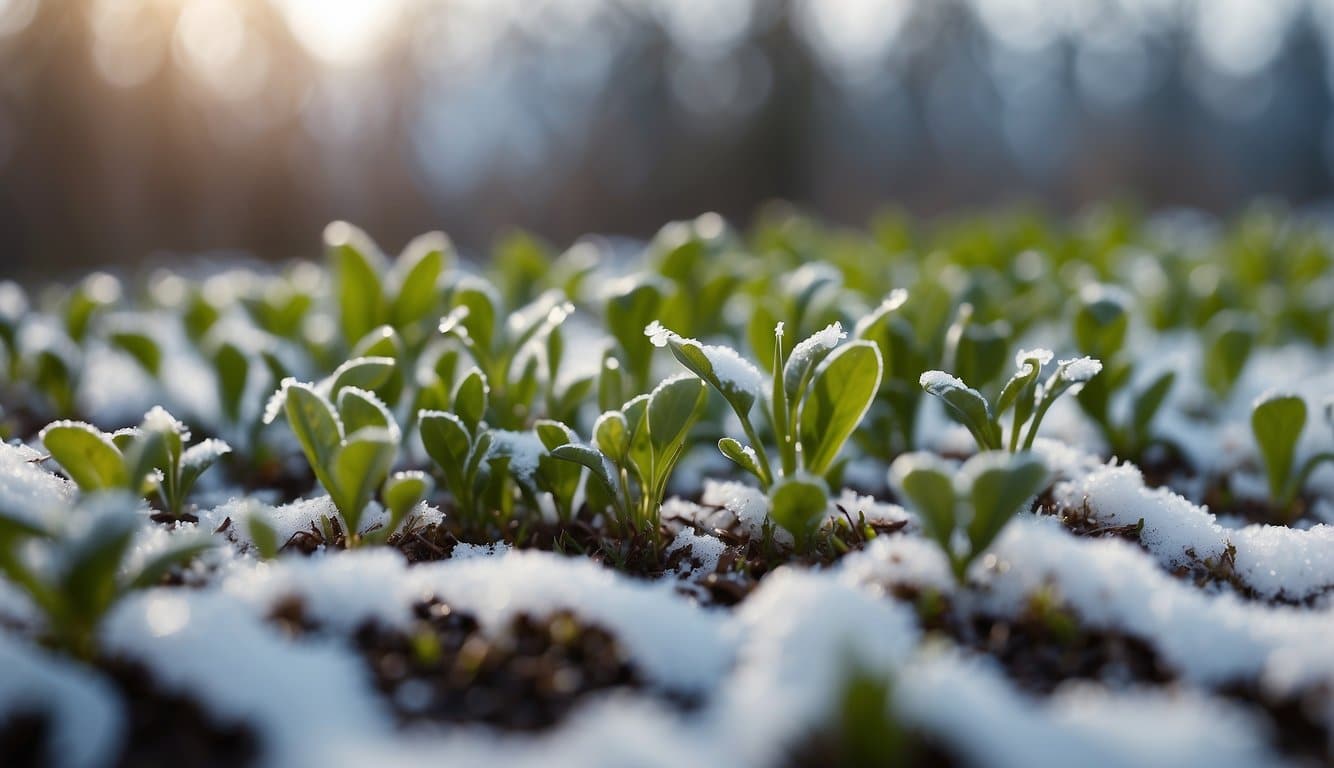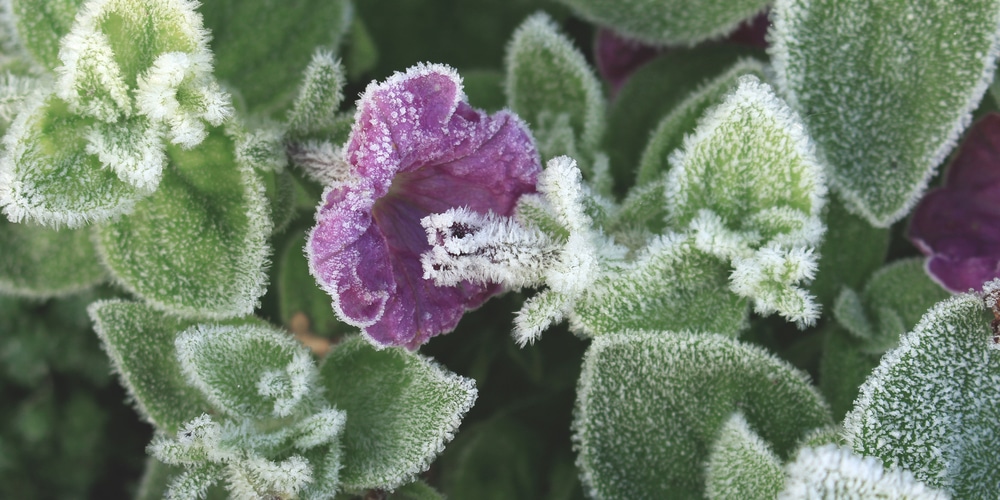Spring Frosts
A spring frost refers to the formation of ice crystals on plant surfaces, often observed during the early months of the year when warmer days are followed by freezing nights. These frosts can be detrimental to young plants, which are particularly vulnerable to sudden temperature drops.
It’s crucial for you to know how to identify and respond to these conditions to protect your budding garden.
Key Factors Influencing Frost Formation:
- Clear Skies: Less cloud cover means more heat escapes into the atmosphere, dropping the temperature near the ground.
- Calm Winds: Without wind, cold air settles near the soil, increasing frost risk.
- Dew Point: When temperatures reach the dew point, moisture in the air condenses and freezes on surfaces.
Types of Frosts:
- Radiation Frost: Occurs on clear, still nights and can be mitigated by covering plants or using water(Horticulture) to retain heat.
- Advective Frost: Comes with cold wind fronts and requires more preparation, such as establishing windbreaks or using greenhouses to shield plants.
Impact on Plants:
- Tender New Growth: Buds, flowers, stems, and leaves are most at risk during a frost.
- Plant Survival: While some hardy annuals may survive, frost can severely damage or kill less resistant plants.
- Covering: Utilize sheets, blankets, or frost fabric to insulate plants.
- Watering: Sufficiently water the soil; wet soil retains heat better, but avoid over-saturation.
How to Select Resistant Plants
When preparing your garden for spring, it’s crucial to start with plants that have a higher chance of surviving unexpected late freezes. Resilience can be key to not losing your tender sprouts to a sudden cold snap.
Choosing Hardy Varieties
- Do Your Research: Prior to planting, ensure that you select varieties known for their frost tolerance. For example, some species of perennials are genetically predisposed to withstand cooler temperatures without significant damage.
- Invest in Quality: Choose seeds and seedlings from reputable nurseries that provide robust and acclimated plants for your specific climate zone. Opt for frost-resistant cultivars that will give your garden a fighting chance against late frosts.
Utilizing Local Plant Knowledge
- Consult Local Experts: Your local extension service or gardening club can offer valuable insights into the selection of frost-resistant plants that are well-adapted to local conditions.
- Observe Natural Growers: Take cues from plants that naturally grow in your area, as they are the epitome of resilience and can provide a framework for what will likely thrive in your garden.
Planting Strategies
To ensure the survival and healthy growth of your young spring plants, strategic planning is essential. This includes selecting the optimal time for planting as well as understanding the role of microclimates in site selection.
Timing for Planting
- Study Your Region’s Frost Dates: You’ll need to familiarize yourself with the local frost dates to time your planting effectively. Avoid sowing seeds or transplanting sensitive seedlings outside until the danger of the last frost has passed. Websites like the Old Farmer’s Almanac offer regional frost date calculators.
- Utilize Weather Forecasts: Keep an eye on the local weather predictions. If a late frost is expected, you might want to delay planting for a few more days or opt for plants that can withstand a surprise frost.
- Start Indoors When Needed: For a head start, sow seeds indoors and keep them in a controlled environment until outdoor conditions improve. This not only gives the plants a stronger start but also extends your growing season.
Site Selection and Microclimates
- Identify Warm Microclimates: Scan your garden for areas that are naturally warmer or protected from cold winds. Southern exposures and walls that retain heat can create microclimates that are more conducive to young plants.
- Avoid Low Areas: Be wary of low spots in your garden, as these can become “frost pockets”. Cold air settles in low-lying areas, increasing the risk of frost damage.
- Choose Elevated or Sloped Sites: If possible, plant on an elevated site or gentle slope which allows cold air to flow downward and away from your plants, as suggested by experts on protecting plants from late frosts.
- Consider Sunlight and Shade: Keep in mind the amount of daily sunlight and shade each area receives. Early morning sun is beneficial for thawing frost quickly but avoid areas that will have prolonged shade which can maintain colder temperatures longer.
Protective Measures
Protecting young spring plants from late freezes is crucial to ensure their survival and proper growth. Implementing strategies like creating physical barriers, employing certain watering techniques, and managing soil can provide significant defense against unexpected cold snaps.
Physical Barriers
Create buffers between your delicate plants and the frosty conditions they face. Here’s how:
- Floating Row Covers: Drape lightweight, breathable fabric over plants. Be sure not to let the material touch the foliage as this can transfer cold.
- Containers or Cloches: Place inverted containers or cloches over individual plants at night to shield them from cold temperatures; remove these during the day to allow sunlight and air circulation.
Watering Techniques
Strategic watering practices can help mitigate frost damage:
- Evening Watering: Water your plants in the late afternoon before a freeze. Wet soil retains heat better than dry soil, increasing the air temperature around the plants.
- Frost Sprinkling: If a light frost is predicted, keep your sprinkler system on. Watering plants during early morning frost conditions can help melt the ice crystals formed on plant leaves.
Soil Management
Well-managed soil can be a savior against the cold:
- Mulching: Apply a thick layer of mulch around the plants to insulate the ground. Materials like straw, leaves or wood chips can be used.
- Soil Composition: Incorporate organic matter into your soil to improve water retention and boost warmth. Organic materials release heat as they decompose.
Monitoring and Response
In your garden’s battle against late spring frosts, staying informed and being able to act swiftly are your two most vital strategies.
Weather Forecasting
- Check Daily: Monitor weather reports daily for frost advisories in your area. Your local weather service or agricultural extension office can be particularly helpful sources.
- Use Technology: Implement weather apps on your smartphone that provide real-time alerts for sudden changes in weather conditions.
Emergency Protection Methods
- Physical Covers: When a frost warning is issued, protect your plants physically by using:
- Sheets or blankets
- Frost cloth
- Burlap
Secure these materials with stones or soil to keep them from blowing away but ensure they do not crush your plants.
- Watering: If frost is expected, water your plants in the late afternoon. Moist soil holds heat better, helping to protect roots and maintain a warmer microclimate.
Frequently Asked Questions
In anticipation of sudden spring freezes, it’s crucial for you to know how to protect your burgeoning garden. These targeted FAQs offer practical advice for safeguarding young spring plants from unexpected cold snaps.
What methods are most effective for covering young plants during a spring freeze?
- Drape lightweight fabrics like sheets or floating row covers over your plants.
- Use overturned buckets or cardboard boxes as temporary shelters.
Can certain materials be used to insulate seedlings from a late frost effectively?
- Employ straw or mulch to insulate the ground around seedlings.
- Utilize bubble wrap or frost fabric as wraps for individual plants.
At what temperature threshold should protective measures be implemented for spring plants?
- Take action when temperatures are forecast to fall between 33-36 degrees F, as frost can form and damage new growth.
How do I safeguard my garden against unexpected late-season frosts?
- Monitor local weather reports for frost advisories.
- Be prepared to cover your plants or bring them indoors if possible.
What are the appropriate steps to take when a freeze warning is issued for a garden with young plants?
- Water your plants the evening before the freeze. Wet soil retains heat better than dry soil.
- Cover your plants securely, making sure to extend the cover to the ground.
Which young plants are most susceptible to damage during a late freeze and require special attention?
- Tender annuals like begonias and petunias are at great risk.
- Early-planted warm-season crops such as tomatoes should be closely monitored and protected.
Last update on 2025-04-02 / Affiliate links / Images from Amazon Product Advertising API





